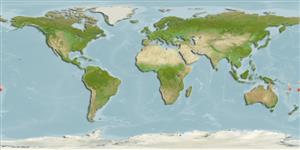>
Gobiiformes (Gobies) >
Gobiidae (Gobies) > Gobiinae
Etymology: Eviota: No etymology given, suggested by Christopher Scharpt: from Latin 'eu' for 'true' and 'iota' for anything very small, in combination 'truly very small' referring to it as being the smallest vertebrate at the time it has benn described by Jenkins (thus, making the suggestion by Scharpt plausible; karaspila: Name from the Greek words ' kara' meaning head and 'spilous' for spot; referring to the distinctive occipital spot; an adjective.
More on authors: Greenfield & Randall.
Environment: milieu / climate zone / profondeur / distribution range
Écologie
marin récifal; profondeur 3 - 23 m (Ref. 85556). Tropical
Western Central Pacific: Fiji and possibly Tonga.
Taille / Poids / Âge
Maturité: Lm ? range ? - ? cm
Max length : 1.8 cm SL mâle / non sexé; (Ref. 85556); 1.7 cm SL (female)
Description synthétique
Clés d'identification | Morphologie | Morphométrie
Épines dorsales (Total) : 7; Rayons mous dorsaux (Total) : 9; Épines anales: 1; Rayons mous anaux: 8. This species is distinguished from its congeners by the following set of characters: a dark, prominent occipital spot; eye 33.7-39.3% HL; caudal-peduncle depth 10.3-12.9% SL; slender body 16.7- 21.3% SL; no dark spots on nape and dorsal midline of trunk; dorsal/anal fin-ray formula 9/8; pectoral-fin rays 16-17, some are branched; cephalic sensory-pore system pattern group I (complete); 5th segmented pelvic-fin ray 8-16% of 4th ray; non-fimbriated genital papilla; absence of 2 orange patches behind the eye in live or fresh individuals (Ref. 85556). Dorsal to anal fin-ray formula 9/8 (Ref. 116739).
Body shape (shape guide): fusiform / normal.
rotenone
Life cycle and mating behavior
Maturité | Reproduction | Frai | Œufs | Fécondité | Larves
Greenfield, D.W. and J.E. Randall, 2010. Eviota karaspila, a new gobiid fish from Fiji (Teleostei: Gobiidae). Zootaxa 2672:61-68. (Ref. 85556)
Statut dans la liste rouge de l'IUCN (Ref. 130435: Version 2025-1)
Menace pour l'homme
Harmless
Utilisations par l'homme
Outils
Articles particuliers
Télécharger en XML
Sources Internet
Estimates based on models
Preferred temperature (Réf.
123201): 26.4 - 28.9, mean 27.1 °C (based on 156 cells).
Phylogenetic diversity index (Réf.
82804): PD
50 = 0.5000 [Uniqueness, from 0.5 = low to 2.0 = high].
Bayesian length-weight: a=0.01023 (0.00477 - 0.02194), b=3.01 (2.83 - 3.19), in cm total length, based on LWR estimates for this (Sub)family-body shape (Ref.
93245).
Niveau trophique (Réf.
69278): 3.0 ±0.3 se; based on size and trophs of closest relatives
Fishing Vulnerability (Ref.
59153): Low vulnerability (10 of 100).
🛈
Nutrients (Ref.
124155): Calcium = 488 [204, 1,989] mg/100g; Iron = 2.23 [0.84, 5.32] mg/100g; Protein = 18 [16, 20] %; Omega3 = 0.163 [0.044, 0.615] g/100g; Selenium = 37.1 [8.9, 124.3] μg/100g; VitaminA = 97.9 [15.5, 588.5] μg/100g; Zinc = 5.87 [2.88, 10.52] mg/100g (wet weight);
